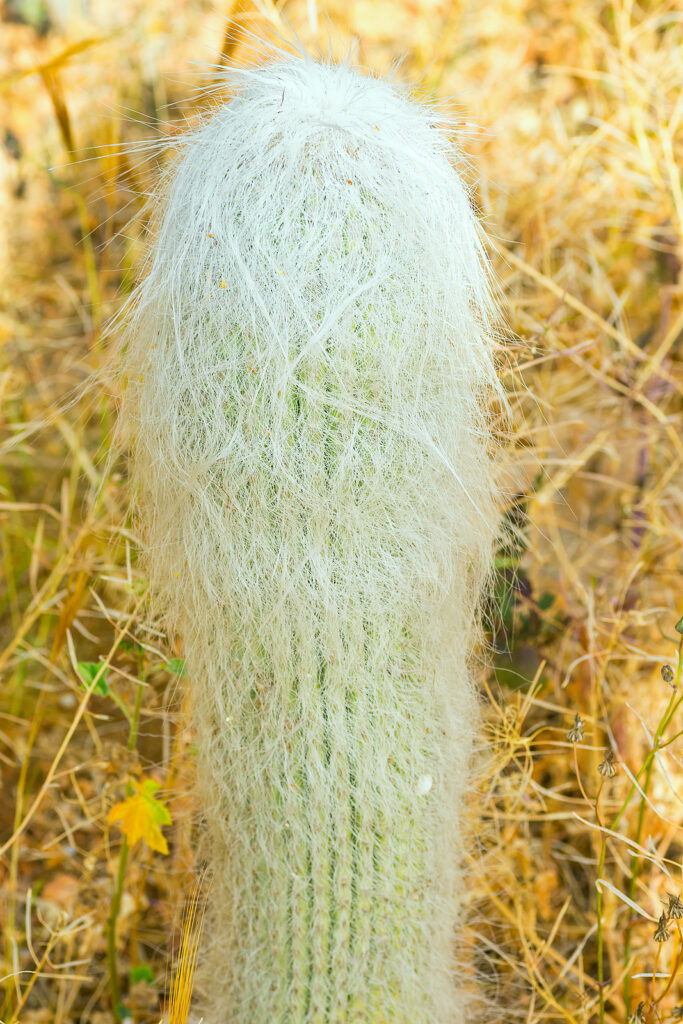Cephalocereus is a genus of tall columnar or branching cacti that are usually covered with long, white, woolly hair. The white, woolly appearance of Cephalocereus gives rise to its common name, old man cactus. It is one of the most popular cacti for beginning growers.
Mature Cephalocereus in optimal conditions can grow to 40 feet tall. They grow much smaller indoors in containers. Cephalocereus bear multiple nocturnal flowers on the upper extremities. They rarely flower when grown indoors.
Get to know Cephalocereus
- Plant type: Cereanae, old man cactus
- Hardiness temperature: 40℉ (4.4℃)
- Optimal temperature: day, 68° to 72°F (20° to 22°C); night, 55° to 65°F (13° to 18°C).
- Shape and size: 12 inches (30cm) to 40 feet (12m) tall
- Flowers: Grow to 3 inches (7.6cm) long and are white or rose colored depenidng on species
- Bloom time: Spring; plant grown indoors rarely flower
- Common name: Old man cactus
- Genus name: Cephalocereus
- Family name: Cactaceae
- Origin: Southern Mexico, Central and South America

Planting Cephalocereus
- Light: Full sun to partial shade
- Indoors grow Cephalocereus in bright, filtered sun from southern, southeastern, or eastern exposure. Fresh air circulation is important.
- Indoors grow Cephalocereus in a cactus/succulent soil mix.
How to water and feed Cephalocereus
- Lightly water Cephalocereus during warm weather. Let the soil nearly dry out between waterings. Overwatering causes plant to rot.
- Indoors Cephalocerus prefers humidity of 30% to 45%.
- Feed Cephalocereus once a year, in spring, with bone meal; for plants at least 1 year old.
Cephalocereus care
- When Cephalocereus woolly hair become matted they can be cleaned with a weak, soapy (not detergent) solution and rinsed thoroughly; comb out any excess soap.
- Pot-on Cephalocereus every spring into slightly larger pot. Support the plant for several days after repotting until it becomes re-rooted and established.
- Allow Cephalocereus to rest from fall to early spring. Place the plant in cool, bright location where it receives 5 hours of sunlight daily. Decrease water during the rest period.
- Be on the look out for aphids and spider mites and treat accordingly.
- Propagate Cephalocereus from cuttings or seeds started in a mixture of half sand and half potting soil.
Growing Cephalocereus as a houseplant
- Cephalocereus senilis, old man cactus, is often grown as a houseplant.
- Cephalocereus requires direct light and a warm temperature.
- It need little water and humidity; the soil should be allowed to dry between waterings.
- Cephalocereus can be fed just once a year in spring.
Cephalocereus species to grow
- Cephalocereus chysacanthus (golden spines). Shrubby plant. Ribbed, bluish stems grows to 15 feet. Bright yellow spines exposed through thick hairy wool. Flowers are rose colored and 3 inches long.
- C. fulviceps (Mexican giant). Multibranched giant species can reach 50 feet tall and up to 1 foot thick. Bluish stems covered with brown woolly hair; flowers are white. Native to southern Mexico.
- C. palmeri (woolly torch, billy goat, bald old man). Hardy plant with short, blue green spines and tufts of long, white, woolly hair. Columnar growth then branching up to 20 feet or more. Three-inch-long flowers are purplish brown.
- C. senillis (old man cactus). Slender, columnar cactus, may branch at base; slow growing to an eventual 40 feet, though usually much less. Tufts of long, grayish white hairs often hide 1 ½-inch yellow spines. Older plants produce nocturnal rose-colored flowers, usually in mid to late spring. Grow as a potted plant indoors or in greenhouse; older plants are striking in cactus garden. Must be protected from hard frost.















